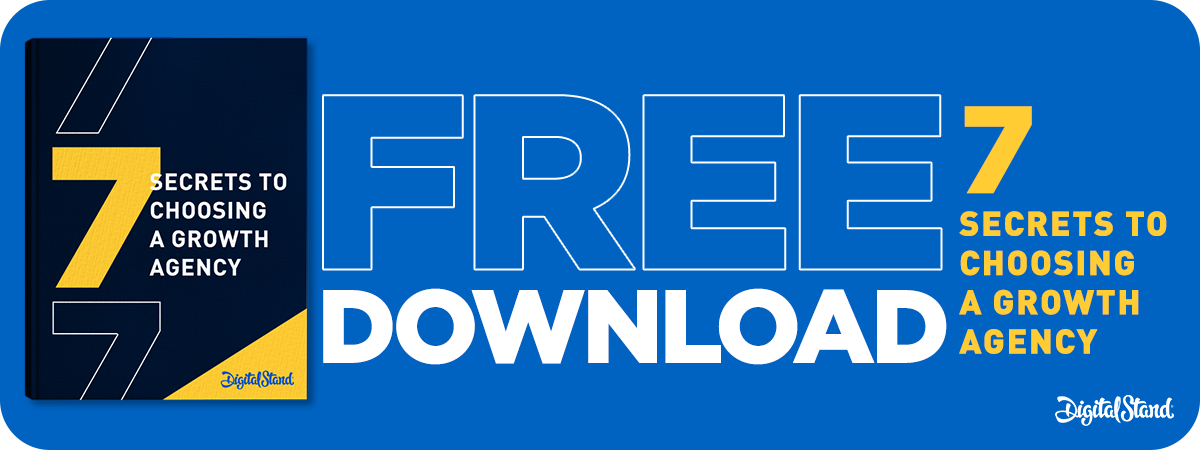Did you know with (PPC) search advertising that a competitor can outbid you, but you can still get more top impressions and at a lower cost?
Did you know that with social media advertising, the better the ad copy and ad, the lower the cost and the better the reach?
Did you know the average landing page conversion rate is 9.7%? But the best can be as high as 50%
Did you know bots will click on your google ads? Presenting zero return to you, but at a high cost. In fact, $5.8 billion globally in 2019
Did you know that Google and Facebook will show different attribution models?
Did you know that your persona/s should now be based on data? Even though they are fictional by nature.
If you answered no to any of the above questions, read on. If you answered yes to all of them, why are you reading this :)?
Let us start at the beginning by first asking:
What is Digital Advertising?
Contrary to generic descriptions, digital advertising is placing the right digital ad or ads, in the right format, at the right time, in front of the right person.
And converting them!
We want to engage our target market emotionally, then intellectually, creating a bias for action.
You can use PPC, Social Media, EDM's, Mobile Apps, Partner Sites, Banner Ads, Native Advertising, Programmatic solutions, or Inbound Marketing as examples.
The medium does not matter, but the performance is critical. And if you can't measure it, you can't count it.
And if you can't count it, you should not spend it.
Digital advertising, by its very nature, lends itself to performance orientation. Or stated another way, my investment must equal my expected return. And I must be able to measure this.
Let's start by breaking down each of the mediums discussed above. And Google would seem the most appropriate place to start. Because as Jeff Bezos said, "Google is like a mountain, you can climb it, but you can not move it."
Google Search Advertising (PPC)
If you do PPC advertising, then you may find this very interesting.
Let's take 4 Advertiser's who are all targeting the same "keyword." With, of course, different copy, and various landing pages and user experience.
Using Google's Ad rank formula, which is calculated by the following formula:
Your bid amount - Your auction time ad quality - Expected click-through rate - Ad relevance - Landing page experience - Ad rank thresholds - Competitiveness of the auction - Context of the search - Advertiser - Max Bid - Quality Score = Ad Rank - Position - Actual CPC.
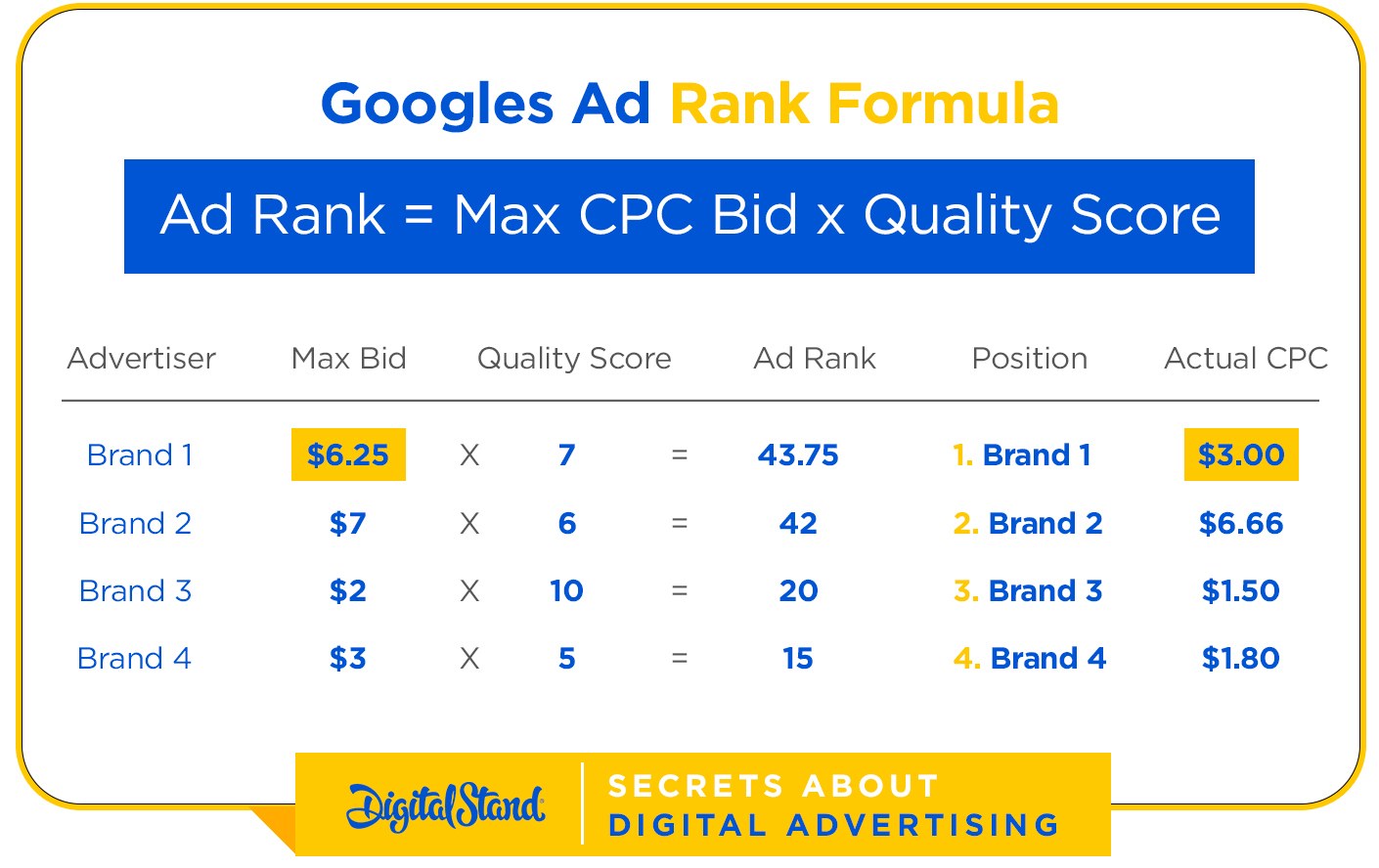
Your ad's quality score affects not only your ad's position but also how much you pay per click—defining the minimum amount you need to beat the other advertisers so they click on your ad.
As explained by Google Chief Economist Hal Varian.
"P1 (the price advertiser 1 has to pay), Q1 (the advertisers quality score) = which has to be just enough to beat the advertiser just below them based on B1 the advertiser's bid Q2 and the quality score of the advertiser below them."
P1 = B1, Q2 (ad rank) /Q1
P1 = The advertiser's ad rank below him, which is his bid multiplied x quality score divided by the quality score of advertiser 1.
"Your actual cost per click is the advertiser's ad rank right below you divided by your quality score."
Did you notice that brand one is paying half the price of brand two but remains in position 1?
By increasing the quality score of your ads, which of course, considers the formula mentioned above, not only reduces your CPC but can maintain a higher position on the page than someone who is bidding more, with a lower quality score.
So irrespective of whether you are advertising in-house or using an external agency, your user experience and ads' quality will dictate the investment required, and no doubt, the return achieved.
To put this another way, having staff or an agency with deep skills in this domain reduces both your cost and increases your return. You are leveraging both ends of the spectrum and allowing for additional advertising spend or resources.
Search Engine Optimisation
Is defined as optimising your website's performance, so you rank for the keywords you want to appear for. You are improving both the quality and quantity of your website traffic.
Rather than paying for the traffic, your goal here is to create a valuable content-rich website that helps your target market solve their problems, understand your industry and make informed buying decisions.
You are making the quality of your content so good that they continue to use your website as a knowledge resource, with the view of converting this traffic into customers.
There are many factors to consider when optimising a website. You need to understand your website traffic and your competitor's website traffic as a baseline.
Some of you may ask, how do I do this? You can use many online tools to do this, but a simple and effective one to start with would be a similar web.
Let's use an example to explain this further. Below is real traffic data from two leading Australian brands. I have compared Brand 1 against Brand 2, and from an outsiders perspective, most would think they are very equal in performance.
However, once you start to analyse the data a very different story unfolds.
Brand 1
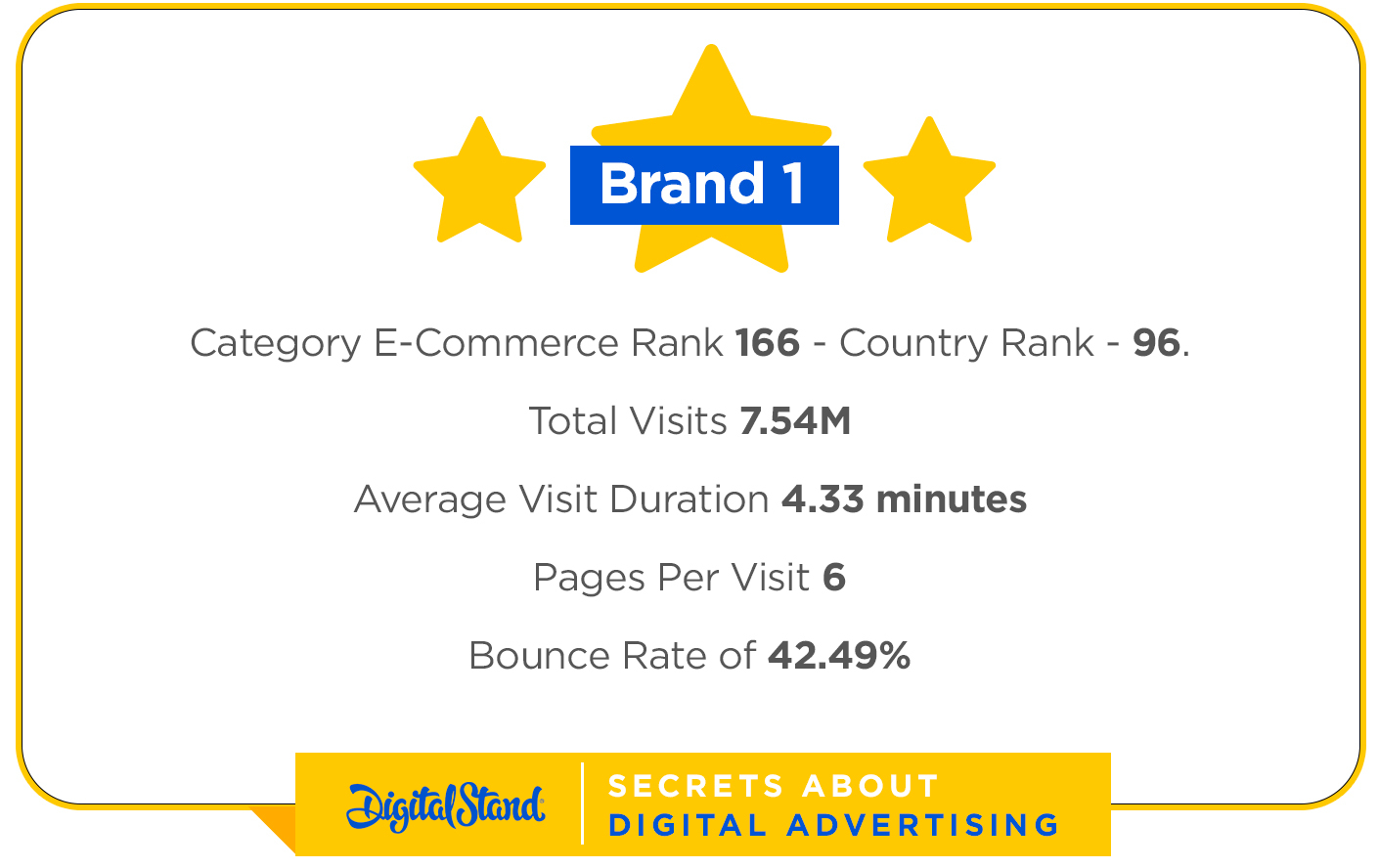
Brand 2
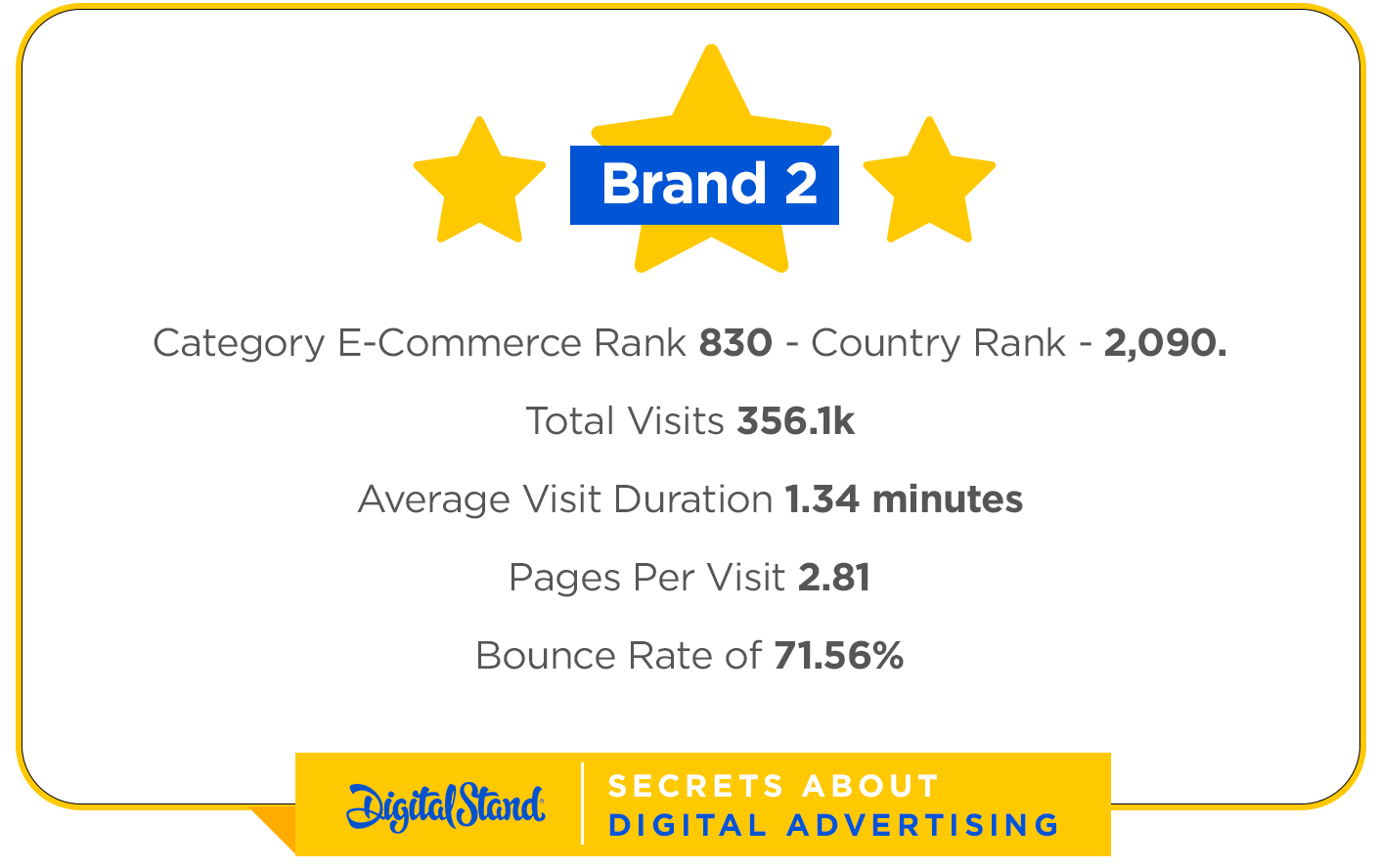
Now it is important to point out in this example both brands would be spending very similar amounts on digital advertising.
If we just use the above analysis when we consider search engine optimisation. It helps us frame not only how we are performing but also how we perform against our peers.
Now, of course, I am missing conversion data! But even though both would have seen significant growth in 2020, there is no doubt based on the above data one of these brands is not even in the same race, despite for all intents and purposes having the same offering.
We can see from the analysis above that we have some work to do if we are Brand 2.
But the bigger question is, what is the work? What do we do to get traffic higher? What do we do to reduce the bounce rate? How do we increase pages per visit and average duration time?
It offers utility to use traditional "Retail" as an example.
We need to increase foot traffic (website traffic), and to do this; we need to understand how Brand 1 is obtaining its traffic?
In Brand 1's case, when we dig a little deeper into their top search volumes are:
- Brand
- Brand Sale
- Brand Online
- Watches for Men
- Brand Dresses
If we are Brand 2, we do not want to optimise our website for any branded terms, but expanding our content around "watches for men" makes a lot of sense (as Brand 2 also sells these, and some would argue have a better range) and this has a monthly search volume of 33,100.
Now in the case of Brand 2, this keyword is in position number 30. And as someone wise once said the best place to hide a dead body is on page 2 of Google. This term for them is on page 3.
Adjusting this search term and aiming to push this into page 1 will enable it to compete for the popular buying term of "men's watches" and lift the monthly traffic and provide an alternative brand choice for the consumer.
In turn, increasing sales. The work required would not be substantial, and both the increase in revenue and traffic would be material.
With SEO our aim is to turn up in search organically when the consumer is looking to solve a problem or educate themselves about the possible options.
When looking at SEO vs PPC, something to consider is that ranking organically and getting clicks in this area is free versus PPC, where you are paying for every click. And the minute you stop paying you will disappear.
It certainly makes sense to use both, but your long-term strategy should be to reduce cost and maximise return, which is where organic traffic has a significant advantage.
It has been shown time and time again that traffic clicked on organically is considered a more trusted source by the consumer then ads. For this very reason alone, optimising for SEO makes sense.
According to HubSpot, 60% of Marketers say their highest source of lead generation comes from (SEO, blog content, etc.) and has a 14.6% close rate.
The other thing worth noting is that there is no cost per click once you are ranking on page 1. But should you be on page 2, there is only a 0.78% chance of the consumer clicking on your link!
Things to consider when assessing search engine optimisation for yourself are:
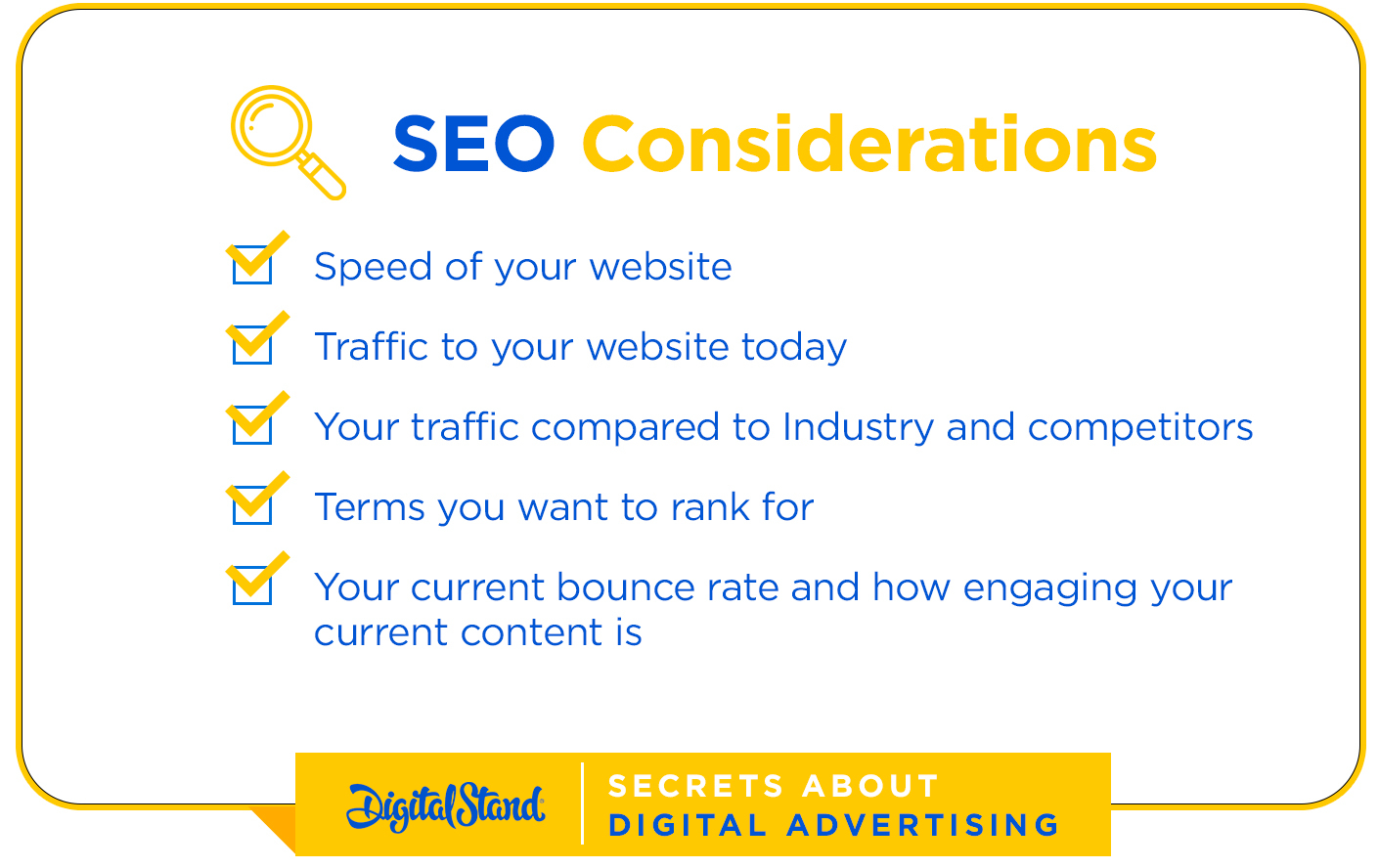
How do you know the speed of your website? Try Pingdom or the Think with Google Website Test.
Banner Ads
Now there are many marketers still using this medium, and without spending a lot of time here, let me provide you with the facts.
According to a deep study in 2019, there is a .05% chance someone will click on your banner ad. Or put another way, just 5 clicks for every 10,000 impressions.
A Nielson study determined that many of us now have banner blindness. This is where visitors to a website, "consciously or unconsciously ignore banner information."
While some will argue that it drives brand awareness, the purpose of digital or online advertising, in my opinion, should only be to drive sales.
We are not big fans of banner ads, so let's move on.
Inbound Marketing
Inbound marketing is the process by which you attract customers by creating contextual content that solves their needs. You may also have heard this interchanged with the term content marketing.
Typically, it is broken down into 3 areas:
- Awareness
- Consideration
- Decision
There are typically three distinct phases of the content we want to produce on the buyer's journey.
Content that helps create awareness about our brand and our capabilities.
Content that educates the consumer/buyers.
Content that seeks decisions or at least drives our buyer towards one.
Inbound marketing is closely aligned with SEO. We are using search terms that take all of the phases into consideration but create valuable content that helps the buyer throughout their journey.
This type of content can and will take many forms, from:
- Blog Posts
- Videos
- Podcasts
- Social Media Posts
- Landing Page/s
- Search Ads
- Social Media Advertising
We have written about this previously here for a more detailed look at how a digital marketing funnel works.
The Awareness Stage
As an example of awareness stage content. I might write an article on "how to choose a social media agency."
Another company might create a tool on "how to design a persona."
Or even a white-paper or E-book on a key subject matter like social media mistakes that you can download to learn more about.
At this stage, as a brand, we must capture an email address or phone number. We need a method to continue the conversation, and without this, we cannot hope to move anyone through the buyer's journey.
But to do this, there must be a "fair exchange" of value. If I want your email address is the content I am providing strong enough for you to say, "fair enough"? I want to hear more from Digital Stand!
The Consideration Stage
At the consideration phase, we are looking to develop our relationship with the buyer further.
At this stage, we want to provide the consumer with case studies in their Industry and our capabilities.
- Advertising calculators
- Website traffic calculators
- Statistics of industry reports
- Checklists
- Content Calendars etc.
Not only providing them with helpful and practical knowledge but also further demonstrating our subject matter expertise.
By demonstrating our expertise, we show what is possible and enable our buyers to fill gaps in their knowledge.
The Decision Stage
Now last but certainly not least is the decision stage.
For this stage in the buyer's journey, we need to offer
- Free trials.
- Live demonstrations
- Consultation offers
- Discounts
- Independent vendor comparison charts
- Case studies
Our goal here is to remove any friction from the buyer's journey altogether.
It is important to note that when we are creating content for this stage, or any of the steps mentioned previously, we want to make sure that the content allows for discovery at any point.
Let me explain just because we are creating logical and sequential content. This does not mean that the buyer will walk through each stage.
Depending on their needs and what they have done to date, they could be at any stage in the process. Or discover one piece of content before another, even though they are not at that stage yet.
They may even stumble across our brand at the decision stage of our process.
This means anyone can consume our ideal decision stage content at any point, and your funnel has to have the ability to enable this.
Marketing Automation
Inbound marketing works best when supported by marketing automation.
When someone who is known to us "reads a blog," "downloads a white-paper," watches "X percentage of video," they are then automatically provided with the next piece of logical content in that step.
Suppose you want to think of this in simple terms. It is the same as Amazon, saying people who bought this also bought this!
Put very simply marketing automation nurture new and existing leads with sequential, personalised content to the point that it is time for someone from sales to reach out to them, or they end up making and enquiry or purchase.
Social Media Advertising
Did you know with social media advertising, you can move someone through a buyer's journey as well?
If they do not know your brand at all, there is a factor you should know about.
It is called the marketing rule of 7. Meaning if I don't know your brand, it is likely to take an average of 7 interactions with your brand before I am comfortable with making a purchase.
Having said this, let's talk about some of the capabilities of social media advertising that you may or may not know about.
To be successful with social media advertising, you need to develop this type of relationship. Meaning they see your brand consistently, and you always turn up!
There are a lot of capabilities that reside within social media advertising that enable us to do this.
This type of advertising benefit is that it enables you to build an audience and a relationship with this audience.
Let's look at several different advertising options.
1. Website Visitors
You can create a list on the social media platforms that track your website visitors. Depending on what suits you best, you can build 30, 60, 90 or even 180-day audiences.
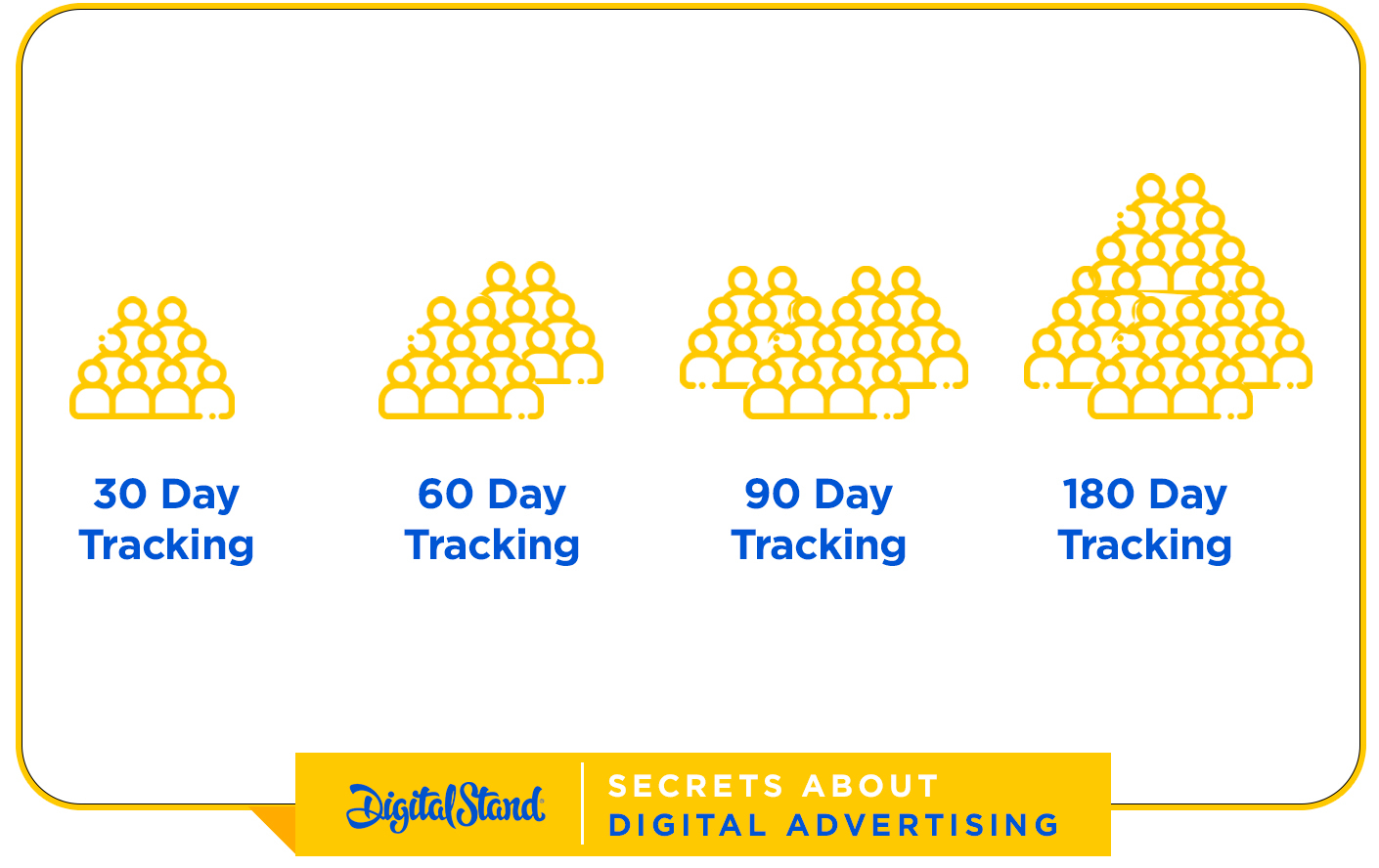
Once your audience is over 1k people, this starts to become functional. As not only can you target this audience, but you can begin to build look-a-like audiences.
This, although, is just a foundational step. Like just making sure your bike has air in the tyres before taking it for a ride.
2. Facebook Engagement Audiences
You can create an audience of anyone who has interacted with your Facebook page over 30, 60, 90 or 180 days.
3. Instagram Engagement Audiences
The same applies to Instagram. The critical point is you can separate Facebook from Instagram in terms of audiences and merge them when advertising if that suits your purposes.
4. Email List Audiences
Fairly self-explanatory, but you can upload your client base to Facebook, Instagram, Google, LinkedIn, or Twitter and create an audience from your database.
You want to make sure your terms and conditions on your website provide for this. But this is also a very effective way of marketing to a known market.
And while I will not mention this again, it is essential to note that any of the audiences mentioned can be cloned or have look-a-like audiences created from the above.
The social media platforms are essentially finding you a new audience derived from the data you are providing it with.
5. Time spent on Page Audiences
Now, this is a compelling option. Not too long ago, Facebook made available the ability to build an audience of your web visitors who spent the most time on your website.
To explain this, simply if you have 10,000 visitors to your website. You can break this down into the top 25% for time on site.
Giving you an audience of 2,500 people who are likely to be very interested in your messaging and content.
6. Lifetime value-based Audiences
A lifetime value-based audience is where you provide some social networks, namely Facebook and Instagram, with deep customer data.
This can include details such as the amount they have spent with you over a period, their address, email, phone number, etc.
Based on this data, Facebook has far greater insights into your key demographic, so when you clone this audience, you are far more likely to find a new audience that converts.
The better the data, the better the outcome.
7. Specific Page Audiences
Every page on your website has a different value.
Let me explain. Your home page, while important, the only purpose should be to lead the consumer and or buyer deeper into your website.
You might want them to look at a product, a service offer, or educate them on your industry, team, work, or market differential.
If you are an E-commerce business and someone abandons a cart, this is a far higher value page than just the home page or even the product page.
So, therefore, targeting segmenting your audience according to pages makes sense.
You may want to run an ad that asks them to come back for an abandoned cart page. Or you may want to run an ad that offers a discount if they check out.
This, in turn, increases your ability to convert them. But it is also a high-value page. So, targeting the audience who looks at this page makes sense.
But what if I am a service business. The same holds true; someone looking at your pricing page poses a far greater likely hood of closing than someone who just read your latest article.
Segmenting audiences based on page views and creating rules for these audiences can be extremely effective. And when you do, you also increase conversions.
8. Video Views
No doubt if you are informed, you understand video content is not only here to stay but is likely the new normal.
With Facebook Advertising, you can track video views in both number and time and build audiences. As an example, let's say we send a video ad out, and over 100k people see it, but only 5,000 watches this video to the end.
We can then create an audience of 5,000 people and serve them with a second video. Or putting this into inbound context, we can serve them with a consideration video or piece of content. They are allowing us to develop the relationship further through advertising.
The Quality of Your Data Matters!
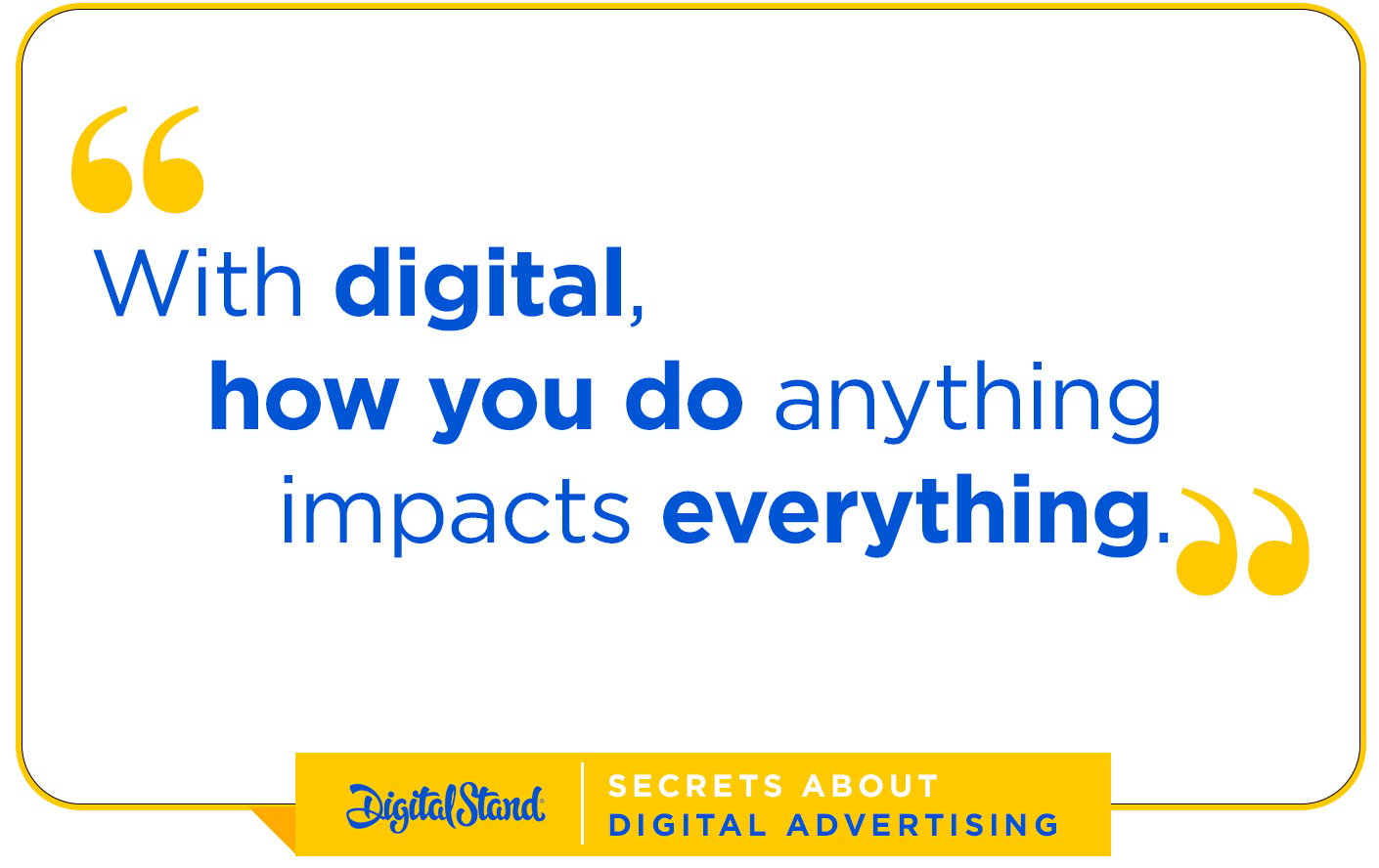
To take a step back for a second, let's assume that we are targeting the right keywords for our brand on our search engine optimisation project. As a result, our ideal lead or potential clients are ending up on our website.
But based on industry standards, we are only converting 2% of these leads.
However, because I have the social pixels in place, I am tracking all visitors, enabling me to re-market to them on social. Increasing my conversion rate but also leveraging my spend in each area.
Irrespective of whether it is Inbound, PPC, SEO, or an EDM campaign.
And if I have the right audience going to my website, I clone this audience based on data. The social networks will find a new, closely related audience matching the data points.
Conversely, if my SEO, PPC, Inbound Marketing is poorly managed, and we are attracting the wrong audience to the website, then I will target an in-effective audience on social.
And when I look to clone this audience, I will further amplify the problem.
Landing Page Optimisation
A landing pages purpose is to convert leads. It does not have to be pretty. It just has to work!
It can be long-form, short-form (both work equally well).
It is typically a stand-alone page from your website that is contextually targeting a particular persona or parties interested in a specific service/product.
Making sure you optimise your landing page for conversion, ensuring your advertising spend is maximised. Sometimes your advertising is excellent, but your landing page loads slowly, has a different copy headline to your ad, different images, and is not optimised for conversion.
Ok, so how do we optimise a landing page, and how do we know if ours is good enough?
Based on a conversion rate study by Un-bounce, the landing page conversion rate across Industry's is 3.57%. And as they are one of the world's best-landing page platforms, they know a thing or two about them.
But to put this in context, they analysed 186.9 million visits to 34,132 UnBounce landing pages.
In 2021 we all know the game is digital, but you are behind the game if you are converting at the industry standard.
While I will not spend much time on this here, you should know that AI is becoming a significant factor in Landing Page optimisation, and in 2021 we have numerous clients using this capability to scale growth.
Should you not be a client of ours or not using AI, below is what you need to consider.
Your Bounce Rate!
How quickly does your landing page load? Remembering the faster it loads impacts your google quality score and typically lowers your adverting cost on search and social.
How compelling is your headline? BuzzSumo researched 100 Million Headlines here is what they found.
A 2018 study found that 59% of all shares on social media networks are not clicked on. This, of course, means that people were sharing content based on the headline only.
So, when we think of our landing pages, the headline is the first thing our prospective client or customer sees. It must be clear, compelling and most importantly, align with your advertising and your persona's needs.
Want to test your headline writing skills? Check out Co-schedules free headline analyser.
How effective is your hero shot? Your hero should, of course, match your messaging but should also show your customers future state.
Show them where you can take them.
Your benefit statement? Why should they consider contacting you?
Ours might be.
"Our data-driven formula means you will start getting new customers within 30-days."
Is your form optimised for conversion?
A significant mistake a lot of brands make on lead forms is they ask for too much.
It must be a "fair exchange of value." If I want your email address, what am I giving in return?
If I want your email address, phone number, what am I giving in return?
If I have a fifteen-field form, is the value worth the exchange? And do I need all this information on the 1st pass?
What about your call to action (CTA)? Is your CTA prominent? Can you work it into your landing page subtly and several times?
Social proof, do you have testimonials on your landing page or case studies?
Do you have a control page (A) and a (B) page? This is a must in 2021. Agile marketing is the only way to market in the future.
With the use of AI, we are now using up to 5 pages for our control. We, of course, will only change one thing per page, such as the headline and let AI optimise the best performing page.
From there, we can test the hero shot, CTA, form etc.
- Are you analysing the data to iterate and improve?
- How fast is your landing page loading?
- What is the bounce rate?
- What is the quality of the leads that are converting?
- What is the conversion rate?
- What is the dwell time?
- What about the button colours (yes, it matters).
Is there good contrast so your button stands out while complementing the design? And is it placed subtly but numerous times on the page and at least once above the fold?
Ok, so we have captured a prospective leads attention and consideration. Let's take a look at:
EDM Marketing
When it comes to email marketing, it distils down to a few areas of importance.
1. Consistency - How frequently you are communicating with your database.
2. Open rate - How interested is your audience with the content you are sharing (which can also be a function of how well your headline has been written.)
3. Click through rate - If you have managed to have your audience open your EDM. Are they engaging with it, determined by your click-through rate.
4. Conversion - If they click through, are they consuming the content you have distributed or converting and buying products you have marketed to them?
I realise for most marketers and business owners, the areas above present nothing new in terms of measuring performance.
Although do you know what your industry performance is? How you compare with your peers, and for that matter, how advanced are your EDM capabilities.
In 2021 you will see a significant increase in Video-based EDM's. This aligns with where we are generally heading across social, and all other forms of digital media.
If you are not using a platform that enables this, soon, you may find yourself at a disadvantage amongst your peers.
As a species, our eyes are attracted to movement. It is part of our survival instinct, and as you may have noticed, a lot of Digital Stand's own EDM's include gifs due to this.
The reality is, it just more engaging.
Now when we come back to performance, there certainly are some key components you must measure yourself against.
Campaign Monitor studied 100 billion e-mails and found that Tuesday is the very best day to send an EDM.
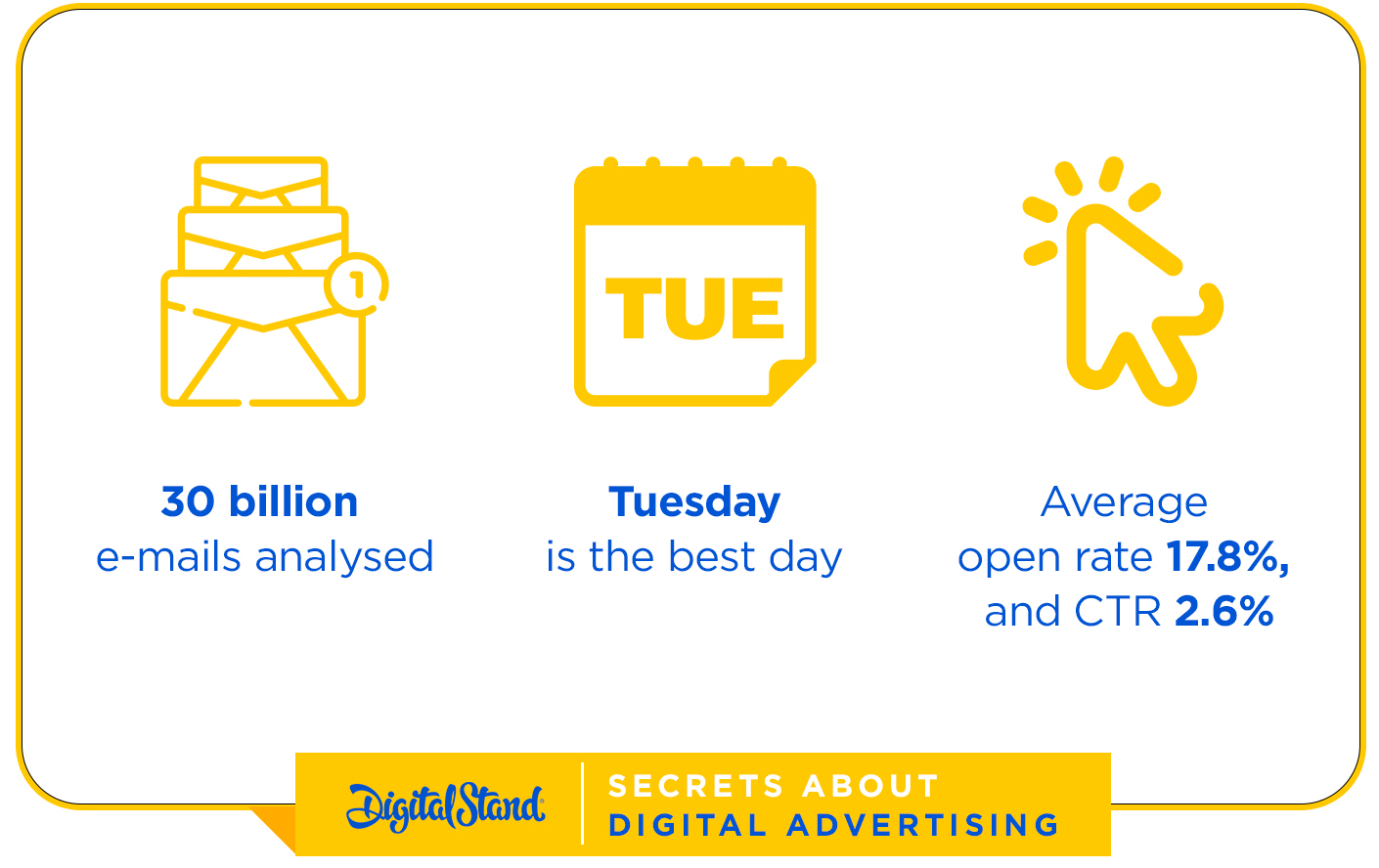
The average open rate was 17.8%, and the click-through rate of 2.6%.
If you find your benchmarks below these numbers, it is probably worth re-visiting your campaign strategy and execution.
Final Thoughts
Digital advertising has now become the most critical part of your marketing strategy and success. This, of course, has been accelerated as a result of COVID. But all that happened is we moved forward a couple of years in a couple of months.
With that said, it is essential to note:
- PPC, Social Media, EDM's, Mobile Apps, Partner Sites, Banner Ads, Native Advertising, Programmatic Solutions, or Inbound Marketing are all connected and should not be viewed in isolation.
- Each area, however, should be judged on its own merits when it comes to click-through rate, ROAS (return on ad spend), or the quality of leads from a landing page.
- The stronger you can make one area, the stronger you make the rest, whether through shared knowledge or the interrelationship between the assets.
- Lastly, if you can't measure, don't spend it!
Since 2013 Digital Stand has been helping companies navigate social and digital media. If you are interested in speaking to us further, you can contact us here or here.

.jpeg?width=200&height=200&name=pexels-mikhail-nilov-6893349%20(1).jpeg)


.jpeg?width=318&height=135&name=pexels-cottonbro-studio-4065876%20(1).jpeg)






